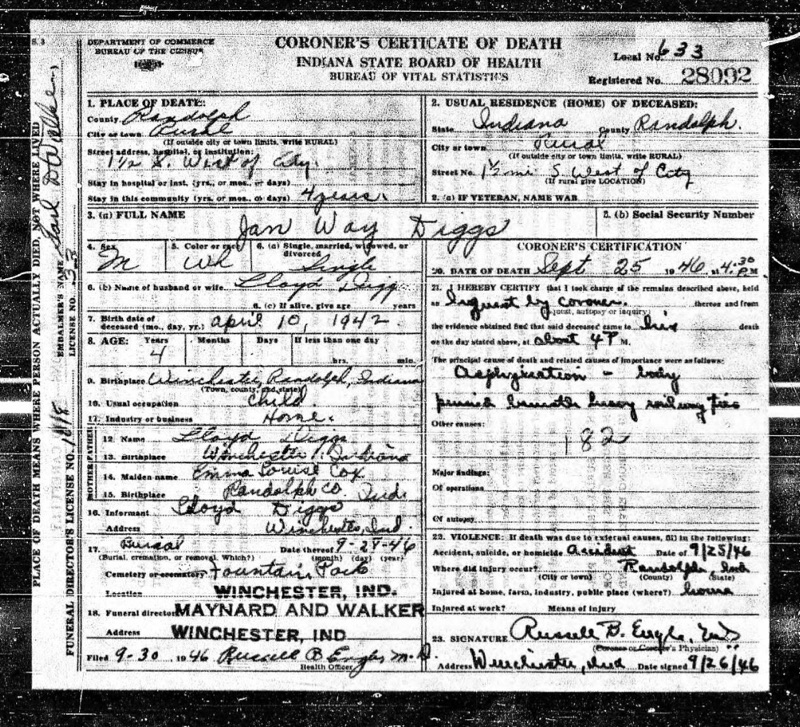
Meet Mick Holloway, our resident expert on all things Randolph County. This lifelong resident of Randolph County is a veritable fount of knowledge with an incredible talent for storytelling, an amazing sense of humor, and a wit to match. You can usually find Mick in the back room at the museum searching through old newspapers for stories to add to his personal collection or doing research for a member of the Society. Mick will be the official blogger for the Society, sharing tales of old.
Wednesday, August 8, 2018
27.Randolph County, Indiana, Black History Interview, Jan. 1959
By Lloyd H. Whitehead, Author of "Modoc-The First 100 Years 1883-1983."
Another "Random Notes" Interview By Mr. Whitehead-Carver and Lou Jordan.
I talked with Carver and Lou Jordan this morning (Jan. 8) about the "Colored meetings" formerly held in the woods across from the Baptist cemetery south of Scott's Corner on State Road #1 just north of Modoc. The following things were gleaned from their recollections: These meetings which were discontinued some 20 years ago, were annual affairs, held on Sundays in warm weather. Similar meetings were held at the grove at the Baptist cemetery, as well as at a place a mile north of the Blountsville school house at the Pat Jordan corner. The first Carver attended on the east of the highway was around 1904. These were fellowship meetings, and drew people from colored churches from as far away as Muncie or Richmond, although transportation was by horse drawn conveyances. They were all-day affairs and featured basket dinners at noon. Preachers were always, as far as he recollects, colored, and the main body of those who took active part in the service were colored also, although many white people attended.
A platform was erected for the preachers and Elders and other dignitaries to set upon and to preach from, and seats made of boards supported on blocks of wood were provided for most of the congregation. Many whites sat in their buggies, or sat in the shade of nearby trees, visiting together or listening to the services. The main attraction, from the standpoint of the whites, was the spirited singing in the peculiar harmony that still characterizes negro group singing. These who attended often shouted and otherwise demonstrated their feelings, to the enjoyment of the believers and the amusement of those who came to be amused, or to scoff.
At the time these meetings were at their peak there was a much greater colored population than at present in this region. Sam Woods, who built the brick house where Oliver Rawlings lived so long, told Carver that in his time a man could begin at his place and walk all the way to Georgetown bridge (over White River, south of Farmland on S.R.#1) without stepping off of land owned or farmed by negroes. This would be a distance of approximately 10 miles. At that that time, both the Baptist, where the graveyard is, and the Methodist Church, which was still standing, were in regular use. The little store at Scott's Corner was in operation at this time. It had been founded by Eleazor Scott, who was the father of Jim Scott, recently deceased, and of the wife of Albert Barrax who is still living. A colored school house at Barrax's a mile west of Scotts Corner and another half mile south of the same place were in operation during or shortly previous to the time when these meetings were at their height. The school south of Scott's Corner as long ago as I (Lloyd) can remember, had been remodeled and was the home of Arie Scott, who at that time was well known as a faith healer of sorts, although he made no particular claim to being religious. He was a Negro; had formerly lived north of Blountsville, was a lover and owner of good horses and worked as a more or less, professional wheat stacker. In that day wheat was cut, bound and shocked a dozen sheaves in a place, then hauled to the stack lot and made into large stacks. After a curing period it was then threshed from these large stacks. It took a certain skill to build these stacks waterproof and symmetrical, and Arie had that skill. Mr. Scott attracted scores of people to his home for healing, and many claimed to have been healed, while others claimed he was a complete fraud. Neighbors said he used leaves from a plant or bush in his garden, although he used no medicine, but rather used them as a witch doctor uses certain properties in his rites. He was reputed to have become rather well off in a financial way at this activity. Many white children also went to these colored schools, so in that early day integration had already been solved in this particular neighborhood. The A.M.E. church has recently been holding these basket meetings at their church, but they no longer attract the crowds that the former ones did. In another set of notes I shall try to speak a little more in detail about the drugless healing practices of this vicinity and some of the persons involved.
Subscribe to:
Post Comments (Atom)
258. Randolph County, Ind. News: 4 Year Old Crushed By Ties.
Coroner's Report To The Clerk of The Randolph County Circuit Court, Winchester, Indiana. Cause: Death of Jan Way Diggs, September 25, 19...

-
Jan. 19, 1952. No answer when you call the police? Have you ever called the Winchester police station and received no answer? Here's...
-
Arba area boy Drowns. July 31, 1930. Headstone for Elbert Alexander, buried at Spartanburg Cemetery. A six days search for the body of El...
-
Coroner's Report To The Clerk of The Randolph County Circuit Court, Winchester, Indiana. Cause: Death of Jan Way Diggs, September 25, 19...

.jpeg)
No comments:
Post a Comment